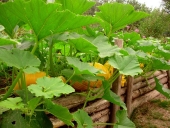













 1
1




 I actually began to like them. But our sheep and alpacas are still eating it after the sweet grasses are gone. You have to leave animals in an area long enough for them to eat their least favorite things.
I actually began to like them. But our sheep and alpacas are still eating it after the sweet grasses are gone. You have to leave animals in an area long enough for them to eat their least favorite things.









Jami McBride wrote: So we began pulling the PO up with our bare hands (lopping gets old and tiring) PO pulls easily, even 1" think stems can be pulled. We stopped taking any special precautions for washing up when we came into the house, just our hands as usual and didn't change our clothes or pre-soak them.
Works at a residential alternative high school in the Himalayas SECMOL.org . "Back home" is Cape Cod, E Coast USA.




 1
1




"You must be the change you want to see in the world." "First they ignore you, then they laugh at you, then they fight you, then you win." --Mahatma Gandhi
"Preach the Gospel always, and if necessary, use words." --Francis of Assisi.
"Family farms work when the whole family works the farm." -- Adam Klaus








Jami McBride wrote:Yes, I guess that's the catch 22 - immunity requires exposure.
 1
1




R Scott wrote:Word of warning: Eating it doesn't work for everyone, and the reaction can be life threatening to a few.
 I have one friend who says they were immune their whole lives and now in their 50's they are starting to react to it. Others have said that after so many years working out of doors they became immune. All I know is we get it bad, but have no way to avoid it - so after years of forgetting to eat PO in the Spring because we lived in the city, I now have my own crop - it's very convenient.
I have one friend who says they were immune their whole lives and now in their 50's they are starting to react to it. Others have said that after so many years working out of doors they became immune. All I know is we get it bad, but have no way to avoid it - so after years of forgetting to eat PO in the Spring because we lived in the city, I now have my own crop - it's very convenient. 
























 go hiking without him and tell him about all the awesome stuff you saw? I love hiking but lately usually go alone.
go hiking without him and tell him about all the awesome stuff you saw? I love hiking but lately usually go alone.  1
1




Cassie Langstraat wrote:Hmm, this is all really crazy! My partner gets poison oak allergy really really bad, like to the point where he refuses to hike anywhere near it and so I told him about this but he said it can be toxic to eat. And you can somehow get the allergic reaction like on the inside of you? Is this true?












 1
1





|
Evacuate the building! Here, take this tiny ad with you:
The new permaculture playing cards kickstarter is now live!
https://www.kickstarter.com/projects/paulwheaton/garden-cards
|




